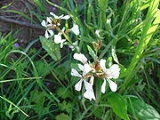
Eruca vesicaria
Encyclopedia
Eruca vesicaria is a species of Eruca
native to the western Mediterranean region, in Morocco
, Algeria
, and Spain
. It is closely related to Eruca sativa; that species is included in E. vesicaria by some botanists either as a subspecies
E. vesicaria subsp. sativa or not distinguished at all; E. vesicaria can be distinguished from E. sativa by its persistent sepal
s.
It is an annual plant
growing to 20–100 cm tall. The leaves
are deeply pinnately lobed with four to ten small lateral lobes and a large terminal lobe. The flower
s are 2–4 cm diameter, arranged in a corymb, with the typical Brassicaceae
flower structure; the petals are creamy white with purple veins, and the stamens yellow; the sepals are persistent after the flower opens. The fruit
is a siliqua (pod) 12–25 mm long with an apical beak, and containing several seed
s.
in the same manner as Eruca sativa.
Eruca
Eruca is a genus of flowering plants in the family Brassicaceae, native to the Mediterranean region.The number of species is disputed, with some authorities only accepting a single species, while others accept up to five species. The following species are accepted by the Med-Checklist:*Eruca...
native to the western Mediterranean region, in Morocco
Morocco
Morocco , officially the Kingdom of Morocco , is a country located in North Africa. It has a population of more than 32 million and an area of 710,850 km², and also primarily administers the disputed region of the Western Sahara...
, Algeria
Algeria
Algeria , officially the People's Democratic Republic of Algeria , also formally referred to as the Democratic and Popular Republic of Algeria, is a country in the Maghreb region of Northwest Africa with Algiers as its capital.In terms of land area, it is the largest country in Africa and the Arab...
, and Spain
Spain
Spain , officially the Kingdom of Spain languages]] under the European Charter for Regional or Minority Languages. In each of these, Spain's official name is as follows:;;;;;;), is a country and member state of the European Union located in southwestern Europe on the Iberian Peninsula...
. It is closely related to Eruca sativa; that species is included in E. vesicaria by some botanists either as a subspecies
Subspecies
Subspecies in biological classification, is either a taxonomic rank subordinate to species, ora taxonomic unit in that rank . A subspecies cannot be recognized in isolation: a species will either be recognized as having no subspecies at all or two or more, never just one...
E. vesicaria subsp. sativa or not distinguished at all; E. vesicaria can be distinguished from E. sativa by its persistent sepal
Sepal
A sepal is a part of the flower of angiosperms . Collectively the sepals form the calyx, which is the outermost whorl of parts that form a flower. Usually green, sepals have the typical function of protecting the petals when the flower is in bud...
s.
It is an annual plant
Annual plant
An annual plant is a plant that usually germinates, flowers, and dies in a year or season. True annuals will only live longer than a year if they are prevented from setting seed...
growing to 20–100 cm tall. The leaves
Leaf
A leaf is an organ of a vascular plant, as defined in botanical terms, and in particular in plant morphology. Foliage is a mass noun that refers to leaves as a feature of plants....
are deeply pinnately lobed with four to ten small lateral lobes and a large terminal lobe. The flower
Flower
A flower, sometimes known as a bloom or blossom, is the reproductive structure found in flowering plants . The biological function of a flower is to effect reproduction, usually by providing a mechanism for the union of sperm with eggs...
s are 2–4 cm diameter, arranged in a corymb, with the typical Brassicaceae
Brassicaceae
Brassicaceae, a medium sized and economically important family of flowering plants , are informally known as the mustards, mustard flowers, the crucifers or the cabbage family....
flower structure; the petals are creamy white with purple veins, and the stamens yellow; the sepals are persistent after the flower opens. The fruit
Fruit
In broad terms, a fruit is a structure of a plant that contains its seeds.The term has different meanings dependent on context. In non-technical usage, such as food preparation, fruit normally means the fleshy seed-associated structures of certain plants that are sweet and edible in the raw state,...
is a siliqua (pod) 12–25 mm long with an apical beak, and containing several seed
Seed
A seed is a small embryonic plant enclosed in a covering called the seed coat, usually with some stored food. It is the product of the ripened ovule of gymnosperm and angiosperm plants which occurs after fertilization and some growth within the mother plant...
s.
Cultivation and uses
It can be used as a leaf vegetableLeaf vegetable
Leaf vegetables, also called potherbs, green vegetables, greens, leafy greens or salad greens, are plant leaves eaten as a vegetable, sometimes accompanied by tender petioles and shoots...
in the same manner as Eruca sativa.

